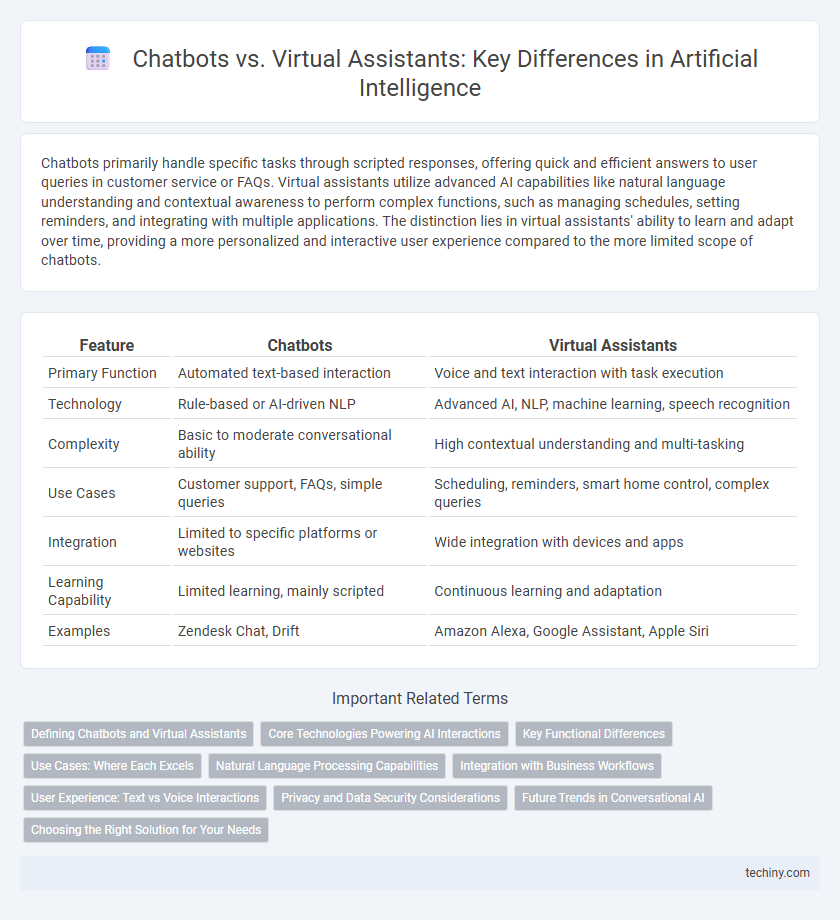Chatbots primarily handle specific tasks through scripted responses, offering quick and efficient answers to user queries in customer service or FAQs. Virtual assistants utilize advanced AI capabilities like natural language understanding and contextual awareness to perform complex functions, such as managing schedules, setting reminders, and integrating with multiple applications. The distinction lies in virtual assistants' ability to learn and adapt over time, providing a more personalized and interactive user experience compared to the more limited scope of chatbots.
Table of Comparison
| Feature | Chatbots | Virtual Assistants |
|---|---|---|
| Primary Function | Automated text-based interaction | Voice and text interaction with task execution |
| Technology | Rule-based or AI-driven NLP | Advanced AI, NLP, machine learning, speech recognition |
| Complexity | Basic to moderate conversational ability | High contextual understanding and multi-tasking |
| Use Cases | Customer support, FAQs, simple queries | Scheduling, reminders, smart home control, complex queries |
| Integration | Limited to specific platforms or websites | Wide integration with devices and apps |
| Learning Capability | Limited learning, mainly scripted | Continuous learning and adaptation |
| Examples | Zendesk Chat, Drift | Amazon Alexa, Google Assistant, Apple Siri |
Defining Chatbots and Virtual Assistants
Chatbots are AI-driven programs designed to simulate conversational interactions primarily through text or voice interfaces, often handling specific tasks or answering straightforward queries. Virtual assistants leverage advanced natural language processing and machine learning algorithms to perform a broader range of personalized functions, such as managing schedules, controlling smart devices, and providing context-aware recommendations. The key distinction lies in chatbots' limited scope for predefined queries versus virtual assistants' adaptive capabilities and integration with multiple applications.
Core Technologies Powering AI Interactions
Chatbots primarily rely on natural language processing (NLP) and rule-based algorithms to interpret user inputs and provide predefined responses, enabling straightforward task automation. Virtual assistants leverage advanced machine learning models, including deep learning and context-aware algorithms, to deliver more personalized and adaptive interactions across multiple platforms. Core technologies such as speech recognition, sentiment analysis, and contextual understanding drive the evolution of AI interactions, enhancing user engagement and functionality.
Key Functional Differences
Chatbots primarily handle specific, rule-based interactions such as answering FAQs or processing simple requests, relying on predefined scripts and keyword recognition. Virtual assistants utilize advanced natural language processing and machine learning to perform complex, context-aware tasks like scheduling, providing personalized recommendations, and integrating with multiple applications. The key functional difference lies in virtual assistants' ability to understand contextual nuances and execute a broader range of functions beyond basic conversational responses.
Use Cases: Where Each Excels
Chatbots excel in handling customer service inquiries, such as order tracking and FAQ responses, providing quick, automated text-based interactions. Virtual assistants demonstrate strengths in managing personal productivity tasks like scheduling meetings, setting reminders, and controlling smart home devices through voice commands. Both leverage Natural Language Processing (NLP) but differ in complexity and scope, with virtual assistants offering broader integration across applications and devices.
Natural Language Processing Capabilities
Chatbots primarily rely on keyword matching and scripted responses, limiting their ability to understand complex queries, while virtual assistants leverage advanced Natural Language Processing (NLP) techniques such as deep learning and contextual analysis to interpret user intent more accurately. Virtual assistants utilize machine learning models like transformers to process natural language in real time, enabling them to handle ambiguous and conversational inputs effectively. This distinction in NLP capabilities results in virtual assistants offering more personalized, dynamic interactions compared to the relatively static responses generated by traditional chatbots.
Integration with Business Workflows
Chatbots seamlessly integrate with customer service platforms to automate FAQs and lead generation, enhancing real-time user interaction. Virtual assistants link with enterprise software, scheduling tools, and email systems to streamline complex workflows and improve productivity. Businesses benefit from the scalable, customizable integration of both technologies to optimize operational efficiency and customer engagement.
User Experience: Text vs Voice Interactions
Chatbots primarily enhance user experience through text-based interactions, allowing for quick, precise responses in messaging platforms and websites. Virtual assistants leverage voice interactions to provide hands-free convenience and natural conversational capabilities, ideal for multitasking environments. Both interfaces prioritize seamless communication but cater to different user preferences and contexts, optimizing accessibility and engagement in artificial intelligence applications.
Privacy and Data Security Considerations
Chatbots primarily process user inputs to provide specific responses, often limiting data retention to improve privacy, whereas virtual assistants typically access broader personal information to perform complex tasks, increasing data security risks. Effective implementation of encryption protocols and compliance with regulations like GDPR and CCPA are critical to safeguard sensitive user data in both systems. Users should evaluate the privacy policies and data handling practices of AI platforms to ensure robust protection against unauthorized access and data breaches.
Future Trends in Conversational AI
Future trends in conversational AI emphasize enhanced personalization and emotional intelligence in chatbots and virtual assistants, driven by advancements in natural language processing and machine learning algorithms. Integration of multimodal interactions, including voice, text, and visual cues, is expected to create more immersive and context-aware user experiences. Continued development in AI ethics and data privacy will shape the deployment of these technologies across industries, ensuring trust and security in human-AI conversations.
Choosing the Right Solution for Your Needs
Choosing between chatbots and virtual assistants depends on the complexity and scope of your customer interactions. Chatbots excel at handling specific, repetitive tasks such as FAQs, while virtual assistants offer more advanced, context-aware support with natural language understanding and multi-tasking capabilities. Assess your business goals and user expectations to determine whether a rule-based chatbot or an AI-powered virtual assistant aligns better with your operational needs and scalability requirements.
Chatbots vs Virtual Assistants Infographic

 techiny.com
techiny.com